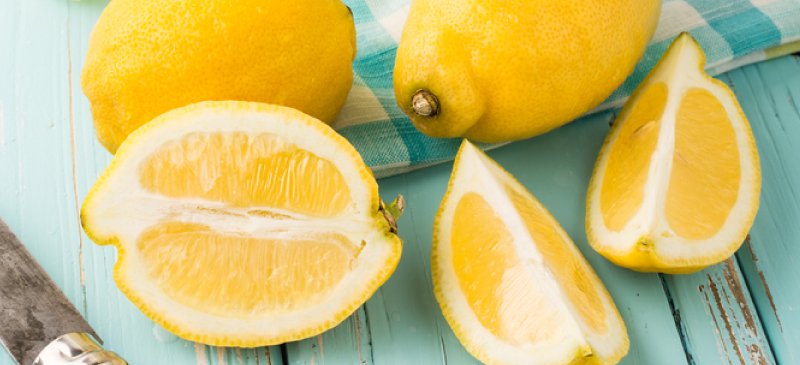The lemon tree (Citrus limonum) originated in India, but throughout time has been acclimated around the Mediterranean basin, for Europe and worldwide, in warm climate regions.
In Hindi, lemon was called “neemo” or “leemoa”. From this word, derived the name “nimbooka”, in Sanskrit, and the name “liomoum”, in Persian. Greek conquerors named it “kitron”, and the Latins, “citrus”. Nowadays, the Italians call it “limone”, the Spanish “limon”, as well as the old French, the English call it “limone”, while the Germans call it “zitrone”.
Born at the foot of the Himalayas, the lemon has always been an interest for the Hindu pickers, since ancient times. From here, it was brought to Persia and Medina, where farmers have acclimatized it and ameliorated it over time. Later, Jews captives in Babylon praised the lemon, giving it a pride of place within their religious celebrations. Thanks to them, the lemon broke into Asia Minor, Crete, Palestine, Egypt, Greece and Southern Italy.
Arabs have contributed to its expansion in Tunisia, Algeria, Morocco, Spain, Portugal, Sicily, etc. After the Crusades, the lemon began to be cultivated in Europe, since the tenth century.
What ancestors thought about lemon?
Initially, the lemon was considered a kind of vegetable gold. It was used to inhibit venom and other poisons, as the poet Virgil recounts in hid poem, “The Georgics”.
Avicena and Porta indicated lemon juice as heart-healthy, Amatus Lusitanus – as diuretic, Holy Hildegard was using it against fever and Silvanicus as a remedy against parasites. In the Middle Ages it was used to prevent vomiting and jaundice.
Every century seems to have discovered the new virtues of lemon leaves, flowers and fruits. Moreover, the current pharmacopoeia verifies and describes the miraculous properties of this plant.
Types of lemons
The lemon tree has several interesting varieties, which have nothing in common with the “golden fruits” in the famous Garden of the Hesperides, guarded by a dragon that killed Heracles.
Similar to the orange tree, but smaller, the lemon tree has supple branches, a green bark, persistent and fragrant green leaves, fragrant white flowers, more or less big golden-yellow fruits.
Common varieties:
- Citrus medica – large, spherical, highly aromatic fruits with slightly acidic pulp;
- Citrus medica acida – small fruits and very acidic pulp;
- Citrus lumia – with spherical fruits and sweet pulp;
- Citrus medica limonum – the common lemon tree of the French, with oval-shaped juicy acid fruits, most commonly used in food and medicine;
- Acid compact peel Eureka, allowing the summer supply, is widely cultivated in Europe;
- In Northern Africa, the most popular lemon is called “four seasons”.
The chemical composition of lemon juice
The composition of lemon peel oil (lemon oil) and juice depends on the species, on the methods of cultivation, on the region. On average, a liter of fresh juice contains:
- 14 to 18 g of citric acid;
- 8-1.5 g of malic acid;
- 7-1.1 g of sucrose;
- 2 g of calcium citrate;
- 1 g of sodium citrate;
- 4 g of protein;
- 4 g of fat;
- 40-50 mg of vitamin C;
- 90 IU (international units) of vitamin A and beta-carotene;
- Small amounts of vitamins B1, B2, B3 and P.
It also contains minerals and trace elements such as phosphorus, silicon, copper and manganese, minerals that strengthen the action of the vitamins, favoring oxidation reduction by stimulating the heart and neurons.
The action of citric acid
Citric acid is extracted from many fruits and vegetables, especially lemon. The juice is precipitated with calcium carbonate, to yield calcium carbonate. Calcium carbonate, treated with sulfuric acid, releases citric acid, a weak organic acid.
In the solid phase, takes the form of water-soluble, brittle, bulky colorless crystals, alcohol and glycerin.
The action of pure citric acid, whether isolated from lemon or synthesized, is not comparable to that of fresh juice. The latter, due to its complexity and catalysts, has a very high medicinal value. At the same time, which is regrettable, the first, easier to preserve and easier to deal with, is an additive used in the preparation of wines, liqueurs, jams, marmalades, mineral water, in order to improve their taste and to preserve them.
The essential lemon oil
Cold-pressed lemon peel abounds in strong-smelling pale yellow essential oil, with a density of 0,857 – 0,861, soluble in 95 degrees alcohol containing terpenes (camphene, limonene, pinene, felandren, citrus and citrolenal, ethyl linalool, linalyl acetate, aldehydes, lemon camphor, etc).
It takes 3,000 lemons to produce one kilo of lemon essential oil.
Another assortment of lemon essential oil obtained by distilling leaves, flowers, stems and small fruits. Not to be confused with lemon essential oil obtained from the peel.
The alkalizing action of the lemon
In the mouth, lemon has a strong acid taste. Therefore it’s believed that it strongly acidifies the body. Totally wrong!
Anionic radicals in the lemon are rapidly oxidized during assimilation chemistry and converted into carbon dioxide, bicarbonates or basic sodium or calcium carbonates. Through this type of reactions, lemon acts as a weak alkalizing, slightly weaker than orange or grapes, but stronger than carrots or beets.
It is recommended that whenever an individual feels gastric acidity due to a bad diet (such as meat abuse, for example) to drink lemon juice.
Lemon for diet
- Lemon has antiseptic and bactericidal role. Lemon juice changes the taste of food, making them more appetizing and digest. A few drops of lemon juice on a clam destroys almost all germs in a quarter of an hour, so before eating clams wait at least 15 minutes after you put lemon juice. In summer, when drinking water seems suspicious, add the juice of half a lemon to 1 liter of water. Do the same with the fish, fruits and vegetables that oxidize readily in the air.
- It’s easier to digest than vinegar. It’s especially advisable for dyspeptics, digesting raw foods easier.
- Lemon with salt. Cut the Gallet lemon (with smooth and fine peel) lengthwise and sprinkle it with fine salt. Allow it for 8 days, then rub and cover it with olive oil, previously aromatized with coriander. Allow to soak for two months. After this time, is served as garnish for chicken and steaks.
- Lemon peel is used in bakery, confectionery and alcoholic beverage industry.
- Lemon jam and marmalade. Green or baked lemon is used to prepare jams. Many people make whole lemon jam, which means they’re using whole lemons.
- Beverages and liqueurs (limoncello). Lemonade is a refreshing drink, recommended especially in summer. The easiest way to make lemonade: mixing the juice of 2 lemons with 1 liter of water.
Beauty benefits of lemon
The lemon is used in various beauty products. For example, Portugal water is made from one liter of 45 degrees alcohol, 4 g of bergamot essence, 25 g of orange peel extract, 12 g of lemon essence.
“Bayadere water”, which attenuates skin spots, is composed as follows: 1l of 85 degrees alcohol, 1 g of rosemary essence, 10 g of Bergamot essence, 3g of neroli essence, 3g of tolu balm.
Children water contains: 1 l 36 degrees alcohol, 3g of lemon essence, 3g of rosemary essence, 3 g of neroli essence, 3g of bergamot essence.
The lemon essence is also part of various perfumes, whose formulas are kept secret by the owners.
Lemon and its uses
Ink stains or fruit and vegetable juice stains on our fingers are removed with lemon juice. White marble will look more beautiful if you rub it with lemon slices and then wipe it with a piece of cotton rag soaked in oil. You can also clean the grill if you use a few slices of lemon.
Between the clothes in your closet, put well dried lemon, mandarin and orange peels. These fragrances, like the lavender, remove the insects. A rotten lemon placed on the ground will keep ants away.
Rub you silver jewelry rub with a lemon slice, rinse it with warm water and wipe it with a piece of deer suede. Cooper objects are also cleaned with lemon slices and then rubbed with coarse salt (sea salt).
Lemons and health
In phytotherapy, the most current applications of lemon are: various inflammation (lung, bowel, liver inflammation), malaria, fever, asthenia, anorexia, ascites, rheumatism, gout, arthritis, kidney stones, gallstones, gastric hyperacidity, stomach ulcer, dyspepsia, flatulence, scurvy, atherosclerosis, varicose veins, phlebitis, capillary fragility, hypertension, obesity, hyperviscosity, pulmonary and bone tuberculosis, demineralization, growth stimulation, convalescence, anemia, jaundice, liver failure, pancreatic insufficiency, hepatic congestion, hemophilia, bleeding (gastrointestinal bleeding, blood in urine), bloating, dysentery, diarrhea, pinworms, asthma, bronchitis, flu, gonorrhea, syphilis, senescence, headache.
Externally, is recommended for catarrh, headaches, nosebleeds, angina, sinusitis, stomatitis, ear infections, thrush, scabies, freckles, glossitis, syphilis of mouth, blepharitis, seborrheic dermatitis of the face, skin rashes, herpes, infected wounds, ringworm, boils, frostbite, preventing wrinkles, insect bites (wasps, bees).
More energetic than phytotherapy, aromatherapy is used cautiously. It is about the essence obtained from the pericarp of the green lemons, richer in essence that baked lemons. It’s used in case of: aerophagia, anemia, ascites, convalescence, demineralization, diarrhea, Slow digestion, capillary fragility, boils, flu, hyperacidity, gallstones, rheumatism, scurvy, pulmonary tuberculosis, varicose veins.
Conclusion
Lemon leaves, flowers, fruits and peal are widely used to protect the health. Lemon is a precious spice for people suffering of dyspepsia, successfully replacing vinegar; moreover, contains vitamins and minerals that nourish the body and purify the blood.
Although is not a universal panacea, the use of lemon improves cellular chemistry and accelerates the elimination of waste through urine. Convalescent, anemic and cardiac patients resort to traditional medicines, but sometimes they use lemon, which in some cases exceeds sodium salicylate.
However, lemons must be used within reasonable limits (typically a lemon per day and at most 10 lemons in maximum cure periods).
Look for quality fruits, preferably grown without chemical fertilizers and insecticides, so is advisable to grow your own lemon tree.







